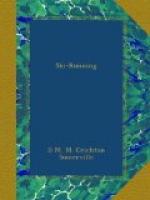Footgear for Ski-ing is not elegant, but as every one wears the same, nobody need feel shy. It is another reason for buying in Switzerland. Ski boots of the right size bought in a London shop look so Gargantuan that people will often insist on having a smaller pair than is really useful when the time comes to wear them.
Spare clothing should invariably be carried on any run beyond the nursery slopes as, in case of an accident and delay in fetching help, a runner who is hurt may be badly frost-bitten. This, of course, only applies to high places during the months of December, January and early February, when the thermometer may often register 32 deg. of frost or more after the sun goes down.
When choosing equipment it is wise, therefore, to remember spare clothing, which should include a Cardigan or Jersey, a dry pair of woollen gloves, a dry pair of socks or stockings, a warm cap of some sort to cover the ears and a scarf. All these should be chosen for a combination of warmth and lightness. A wind-jacket is often recommended. Some people carry a thin silk, or oil silk, or even chamois leather, or paper waistcoat, to put on under their coats when a wind blows. This is not necessary for any but long tours in midwinter. A very useful “sail-cloth coat” specially made for Ski-ing can be bought in most Swiss sports-shops and is excellent.
The great thing to remember about clothing for Ski-ing is that climbing uphill you will probably get very hot and perspire freely. To stop in a biting wind in this condition without putting on spare clothing is obviously risky. It is difficult to ski freely in heavy thick clothes, so that everything should be warm and loose and made of wool except, perhaps, the wind-jacket or the Swiss coat, which can be worn over a sweater.
Cotton or linen underclothing will probably soon be discarded, but this is a personal matter, and need not be dealt with here.
EQUIPMENT
The minimum amount of equipment should be purchased before going out. The Swiss shops are just as well provided with Ski-ing necessities as the British and it is expensive to take out heavy luggage. Most Swiss hotels will gladly store Skis or gear of any kind through the Summer, and these can be posted or forwarded by rail to any place the runner chooses for the following season.
Clothing has been dealt with in a former chapter. Here I propose to describe the equipment which I know, from experience, to be useful.
Skis can be bought in England or in Switzerland. One or two English firms, such as Lillywhite, which really take pains to obtain the best possible quality of goods, may be trusted to provide Norwegian Skis, but there are also several makers of good Skis in Switzerland. Skis should be made either of hickory or ash. Other woods such as birch and walnut have been tried but these do not appear to make as satisfactory Skis




